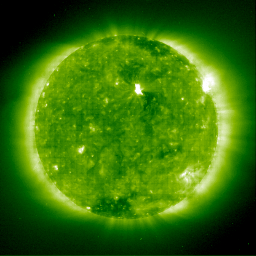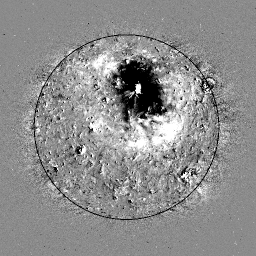
Moreton Waves

Figure 1. a) H alpha image of a Moreton wave at 02:47 UT on 24 September 1997, b) SOHO/EIT 195 Å (dominated by the Fe XII emission line) coronal image of the wave at 02:49 UT, and c) H alpha image of the wave at 02:50 UT. The speed of the wave varied spatially and temporally, ranging from 250 to over 600 km/sec. The flaring active region is visible in all three images. H alpha images courtesy of Barry Reynolds, Perth, Australia.
Moreton waves (Figure 1) are ideally observed in the wings of H alpha, and appear as semi-circular fronts propagating at speeds ranging from several hundred to over a thousand km/sec. They form an arc, or "brow shape" which can span up to 180 degrees. Extrapolating the speed and locations of the arc indicates that the phenomenon's origin intersects well with the impulsive phase of the associated H alpha flare (if the flare exhibits an impulsive phase). However, the arc may not form or may not be observable until it is tens of megameters from the flaring region, and subsequently can propagate to distances exceeding 100 megameters. The high speeds and distances of propagation, plus the associated radio and energetic particle observations, provided strong evidence of a coronal, rather than a chromospheric origin. The H alpha manifestation of the wave is assumed to be the "ground track" or "skirt" of a three-dimensional disturbance.
The red- and blue- shifts of the front propagating on the solar disk into the wings of H alpha appear to indicate evidence of chromospheric depression (and subsequent relaxation) as the wave propagates. The thin arc-shaped structure of the wave, the assumed force which would be required to cause depression in chromospheric features, and their association with Type II radio bursts led observers to conclude that these were shock waves or "blast waves" initiated by the flare.
The "ideal" observations of Moreton waves, however, may not represent all of the actual events observed. Although the "depression" interpretation fit some observations well, some other "wave" observations did not exhibit strong Doppler shifts in H alpha, and some of these "waves" were best observed in emission at the H alpha line center. Furthermore, some observations consisted of additional emission superposed on pre-existing structures, instead of the temporary enhancement of a feature due to a compressional disturbance propagating through it. It was concluded that these additional observations were best explained as ejectra moving above the chromosphere. The ejecta, which could be prominences or other moving material, could display speeds and structure comparable to those of the prototypical Moreton waves. Had this not been the case, perhaps these observations would have been considered as a phenomenon separate from Moreton waves. However, the wave observations consisting of ejecta and those consisting of depression fronts could also be two aspects of the same phenomenon. The shock wave front could be observed in emission while its impact on the chromosphere could be seen in the depression of chromospheric features.
Several other observations have also been tentatively classed as Moreton waves. Before direct observations of wave disturbances were obtained in 1960, observers determined that there was evidence that a flare could initiate another flare or the abrupt activation or oscillation of a filament. Radio observations, and the eventual observation of Moreton wave transients in the corona suggested a means of communication between the causal event and the affected region. Therefore, sudden filament activity, additional flaring and transient chromospheric brightenings have been identified as wave-associated effects. The inferred speeds of a wave transient (frequently lacking the actual observation of a wave), propagating between a flaring region and an initiated observable phenomenon, could exceed 4000 km/sec. In the absence of supporting wave or radio burst observations, some of these measurements fall under suspicion of being coincidental and not associative.


Figure 2. a) SOHO/EIT 195 Å image of the sun on 12 May 1997 at 05:24 0 UT. b) SOHO/EIT image at 05:07 UT with the pre-event image at 04:34 UT digitally subtracted from it. White (black) regions denote increase (decrease) in emission. The dark regions near the active region visible in both images are darkened regions associated with a coronal mass ejection. The bright circular ring of emission outside the darkened regions in the right image corresponds to an increase in emission propagating at 250 km/sec.
Recent observations by the Extreme ultraviolet Imaging Telescope (EIT) on SOHO have provided unambiguous evidence (Figure 2) for large-scale coronal impulses initiated during the early stage of a coronal mass ejection. These waves are typically of lower amplitude than the Moreton wave shown in Figure 1, can extend 360 degrees surrounding the initiating region, and usually propagate passively through the corona, leaving no observable signs of alteration. It is unclear whether these impulses observed by EIT correspond to the low-amplitude (and hence unobservable in H alpha) limit of Moreton wave phenomena, or whether these waves have a different nature entirely.
A clearer understanding of the various phenomena which have been classified as Moreton waves relies upon more thorough observations and an increased understanding of their initiation mechanism. Solar flares and coronal mass ejections are magnetic reconfigurations utilized by the solar corona to liberate excess magnetic energy. In expelling flux and mass via a coronal mass ejection, however, the corona frequently undergoes an additional reconfiguration in the form of a solar flare. For this reason, it is extremely difficult to extricate the actual driver or cause of Moreton waves.
A coronal mass ejection will deliver an impulse to the surrounding corona as the ejection propagates and expands. Some of the SOHO observations have given evidence that some of the wave transients are driven by this effect. However, as mentioned previously, the timing and origin of H alpha Moreton wave observations coincide well with H alpha observations of flares. Because our current understanding of solar flares has advanced beyond the interpretation of "massive bomb-like explosions," the wave initiation mechanism is unclear. Possible candidates are radiation pressure, rapid thermal expansion, and accelerated particle drivers.